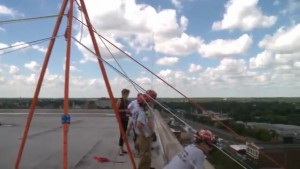Take a look at the first video in the link below. It’s a news story out of Fort Wayne, IN that I assume was supposed to be a simple feel good piece highlighting the local rope rescue team. If you want to jump right to the good stuff, go to the 2:10 mark in the video. What you will see is a really big, really expensive mousetrap.
I do feel a little bit bad about Monday morning quarterbacking this video… but not enough to cause me not to do it.
First, the critical point at the Kootenay Carriage. It would appear that there are two track lines, and two upper control lines (although no lower control lines) with tails going down to the rescuer and victim. The Kootenay, however, remains a critical point. Do I think it will fail? No. But we rig for failure caused by human factors, not equipment factors. Should that Kootenay fail though, the basket could take a major and possibly fatal swing fall.
Second, there is difficulty with attempting to get the basket back up over the edge after they took a ride down and back up the track lines. The reason given in the report is that the “ropes stretched”. While I don’t doubt they stretched, take a look at the link the news story below the youtube video. The second video is extra footage they got while doing the shoot. It is obvious from watching it that they were going to have this problem. While initially loading the basket over the edge you can see how far it drops down when it is initially loaded. It’s about the same distance that they are below the edge when they come back up.
Rope stretch? Maybe. Foreseeable problem? More likely. I’m curious if the attendant could have stood on the end of the basket in order to raise the head up and over the edge. Also a factor is the excessively tall bridle they use. Judging by the video, I’m guessing from the bottom of the basket to the top of the carriage to be six feet in height.
Third, you can see from this picture just how close the resultant is to being outside of the footprint of the tripod. When the track lines were tensioned to raise the load, I’m curious if the friction in the pulleys caused them to temporarily move the resultant until they found their center again.
Fourth, two statements made during this gave me a bit of heartburn. The first is that the “white rope didn’t work the way it was supposed to.” Ropes work exactly as they are rigged. Unless it broke under tension due to unseeable chemical degradation, it was rigging failure. It’s hard to tell what the white lines were rigged to, but I’m guessing they got pulled up off of whatever they were on. The second statement is that “nobody was dropped…they were lowered”. If it was unexpected and uncontrolled, it was a drop. Maybe I would have been inclined to say the same thing out of embarrassment while on camera, but lets call it what it is.
Last, neither the reporter in the basket, nor the one on the roof seen just before the tripod topples, have a helmet on. If I were running this show, it probably would have been an afterthought for me too. Having seen this video, I’d be willing to bet it would be a fatal blow if a tripod toppling like that hits you in the head, helmet or not.
I do applaud Ft. Wayne TRT for allowing this to air (if in fact they had a choice). It’s sometimes hard to admit a goof up. It’s even harder to have it on tape for guys to critique from a distance without knowing the full circumstances (me). The least we can do is try to learn from it.
More footage in the second video here:
http://wane.com/2014/09/05/safety-at-center-of-high-angle-rescue-training/

